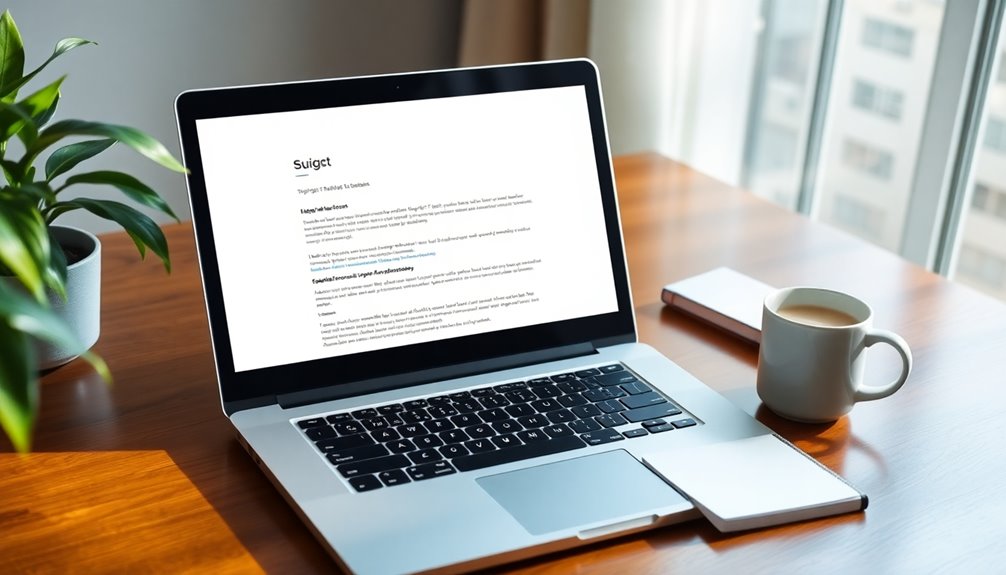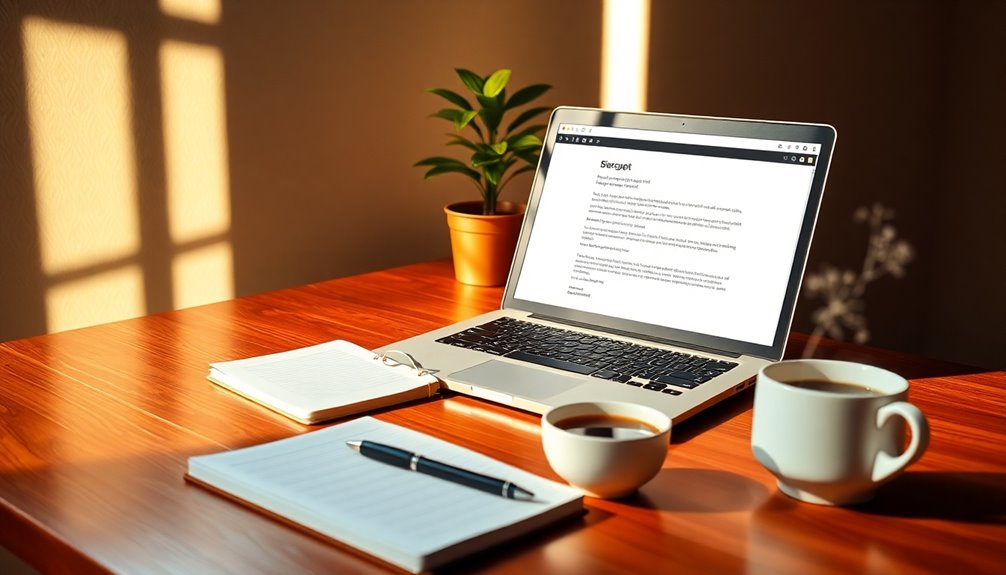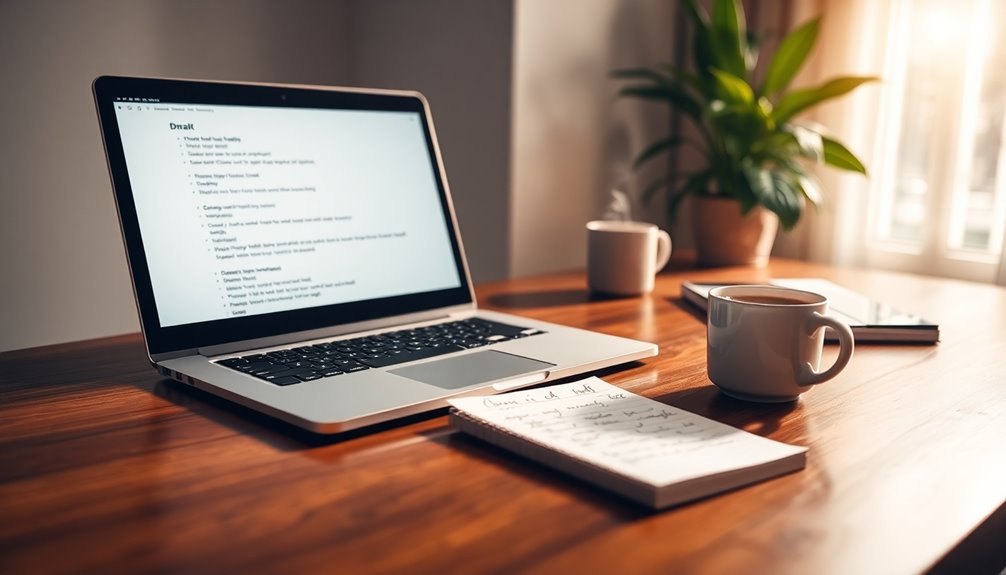To write a clear and respectful email to your professor, start with a formal salutation, like "Dear Professor [Last Name]." Make sure your subject line summarizes the email's purpose. State your request or question in the opening lines, and provide necessary details like your name, course title, and section number. Keep your language concise and avoid unnecessary fluff. Always use proper grammar and proofread for errors. Close with a courteous sign-off, such as "Best regards." Following these tips can improve your communication. Want to explore more strategies for effective email communication?
Key Takeaways
- Use a formal salutation, such as "Dear Professor [Last Name]," to show respect.
- Clearly state your full name, course, and section number in the introduction.
- Directly express your inquiry or request within the first few sentences.
- Maintain a respectful tone and use formal language throughout the email.
- Proofread for spelling and grammar errors to ensure professionalism.
Introduction

When reaching out to your professor via email, it's crucial to make a positive impression from the start. First, use a formal tone throughout your message. Begin with a respectful salutation like "Dear Professor [Last Name]," which conveys professionalism.
Next, focus on crafting a clear subject line that summarizes your email's intent. A clear subject helps your professor understand the purpose of your email at a glance.
In the opening lines, directly state your question or request. This ensures that your professor knows exactly what you need and can respond appropriately. Avoid vague language that could lead to confusion.
Also, remember to maintain a respectful tone; politeness goes a long way in professional emails.
Once you've written your email, take a moment to proofread your email for spelling and grammar errors. Attention to detail reflects your commitment to effective communication and respect for your professor's time.
Builds Professional Relationships

Building professional relationships with your professor starts with effective communication. When you write your emails, using formal language and proper grammar is crucial. This shows you respect your professors and understand the importance of their time. A clear subject line helps them immediately grasp your email's purpose, fostering efficient dialogue.
Engaging in thoughtful email exchanges can open doors to mentorship or research collaborations down the road. Remember, every interaction is an opportunity to build rapport. When you follow up, keep your tone polite and professional. This reinforces your commitment to maintaining a respectful relationship.
Always close your emails with a courteous sign-off like "Best regards." This small gesture can leave a positive impression, making your professor more likely to respond favorably.
Consistent adherence to email etiquette not only reflects your professionalism but also contributes to a positive academic environment. By demonstrating respect and clarity in your communications, you encourage open dialogue and create a foundation for future interactions.
Key Elements of a Great Email: Clarity
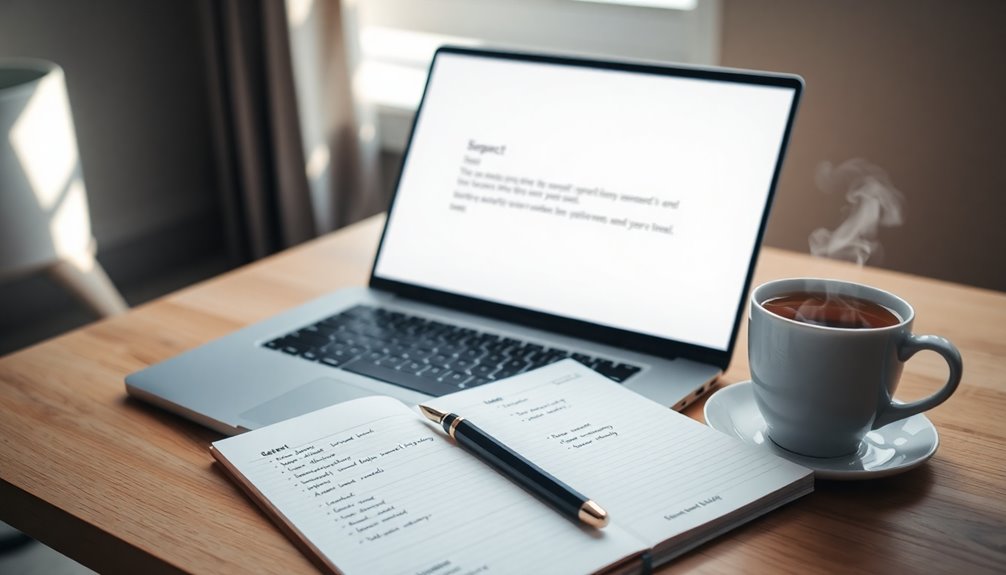
Clarity is essential in your emails to professors, as it ensures your message is understood right away. Start with a clear subject line that succinctly conveys the purpose of your email, like "Question about Assignment Due Date." This helps your professor prioritize your message.
Within the first few sentences, state your inquiry or request directly. This approach allows the professor to grasp your main point immediately.
Don't forget to provide relevant context by mentioning the class name, section number, and any specific details related to your question. This information can help your professor respond more effectively.
Use concise language throughout the email; aim for brevity while still being respectful of their time. Avoid unnecessary details that could clutter your message.
Lastly, proofread your email carefully to catch any spelling and grammar errors. Mistakes can undermine your professionalism and lead to misunderstandings, so it's worth the extra effort.
Step-by-Step Email Writing Tips

Effective email communication with your professor involves following a structured approach. Start with a clear and concise subject line that reflects your purpose, like "Inquiry about Assignment Due Dates." This gives immediate context to your email.
Next, use a formal salutation. Address your professor as "Professor [Last Name]" or "Dr. [Last Name]" to show respect. In your introduction, briefly state your full name, course name, and section number. This helps your professor identify you among their students.
Once you've set the stage, clearly articulate your question or request. Be specific about what you need help with to avoid confusion. For example, if you're unsure about an assignment deadline, state that clearly. Additionally, remember that clear communication is essential in academic settings to foster positive relationships with faculty.
Dos and Don'ts for Student Emails
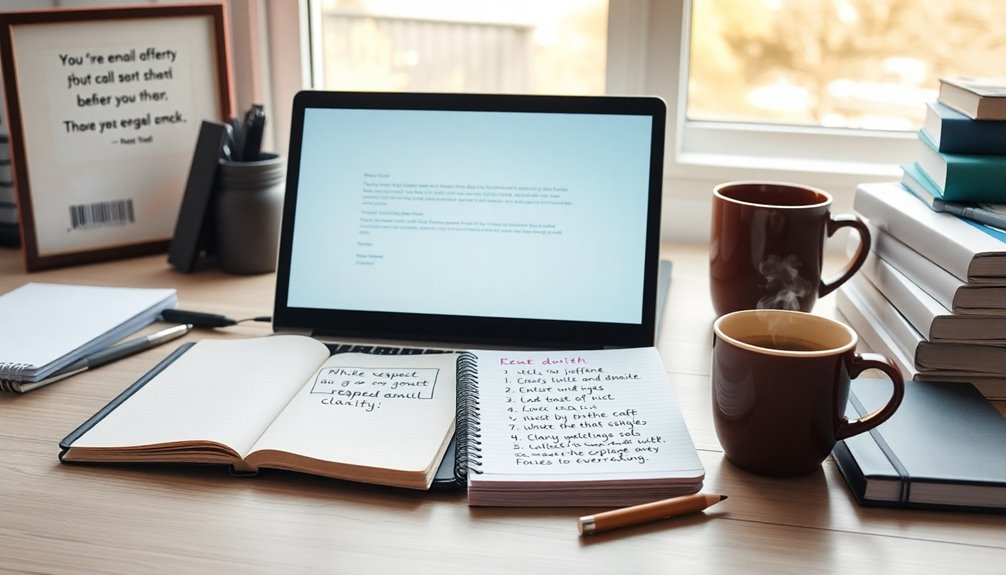
Finally, before hitting send, make sure to proofread your email for spelling and grammar errors.
This shows professionalism and respect for the professor and the academic environment.
By following these dos and don'ts, you'll create effective communication that fosters a positive relationship with your professors.
Examples of Student Emails
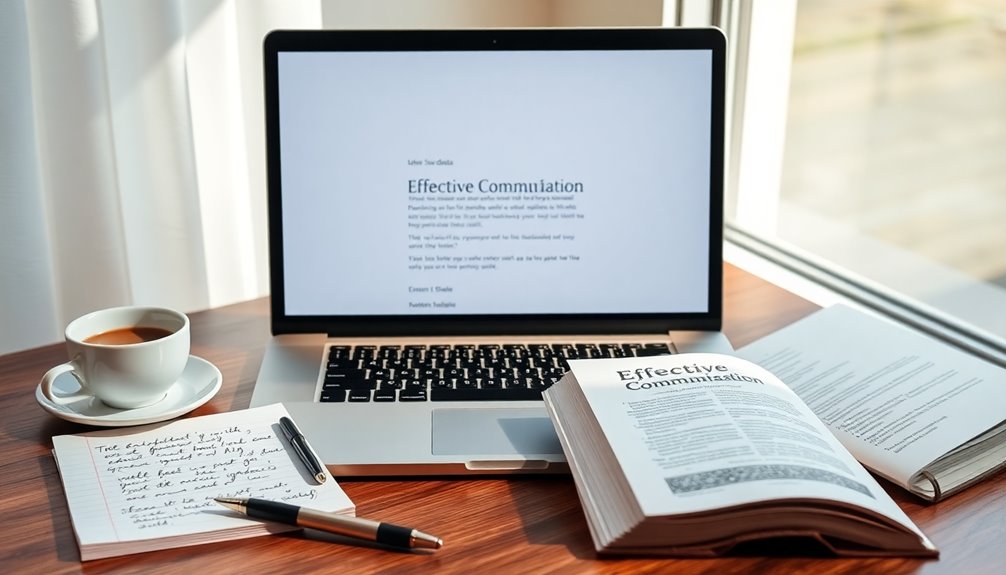
Crafting a well-structured email to your professor can make a significant difference in how your message is received. When you write, start with a formal salutation: "Dear Professor [Last Name]," to show respect.
Then, introduce yourself by including your full name, the class name, and section number. This helps your professor know who you're right away.
In the first paragraph, clearly state your purpose. For example, you could say, "I'm writing to inform you about my absence in [Class Name] on [Date]." Keeping your message concise ensures it's easy to understand. If you have a question or a request, make it straightforward and specific.
Before hitting send, always proofread your email. Spelling and grammatical errors can undermine your professionalism.
Pro Tips for Writing Effective Emails

When you're reaching out to your professor, it's crucial to keep a few key strategies in mind to ensure your email stands out for all the right reasons.
First, make sure to use the correct title when addressing your professor—"Professor" or "Dr." followed by their last name shows respect and professionalism.
Next, craft a clear subject line that summarizes your email's purpose; this makes it easier for your professor to identify and prioritize your message.
In your introduction, briefly state who you're by including your full name, course, and section number. This context helps the professor remember you among many students.
Then, clearly state your question or request within the first few sentences. Avoid unnecessary details; clarity is key.
Final Thoughts
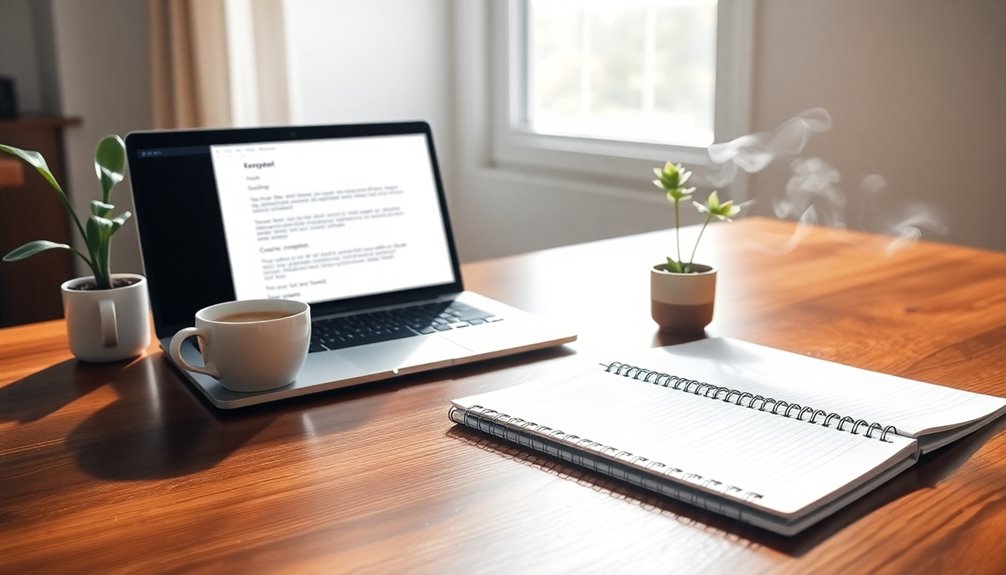
Effective communication with your professor sets the tone for a positive academic relationship. When you email your professor, always start with a professional salutation, like "Dear Professor [Last Name]." This small gesture conveys respect and formality.
Make sure to include specific details, such as your course name, section number, and the nature of your inquiry, whether it's about an assignment due or a request for clarification on an assignment.
A respectful tone goes a long way in fostering good rapport. Proofreading your email for spelling and grammar errors shows professionalism and attention to detail, which can enhance your professor's perception of you.
Don't forget to close your email politely, using phrases like "Thank you" or "Sincerely." Always include your full name at the end to ensure clarity in your identity.
By following these guidelines, you'll create clear and respectful emails that not only convey your message effectively but also strengthen your relationship with your professor.
Frequently Asked Questions
How Do You Write a Clear Polite Email to a Teacher?
When you write a clear, polite email to a teacher, start with a formal salutation, like "Dear [Teacher’s Last Name]."
Clearly state your purpose in the opening lines to grab their attention. Briefly introduce yourself, including your full name and the course you're in.
Use concise language to respect their time.
How Do You Write a Polite Follow up Email to a Professor?
When you write a polite follow-up email to your professor, start by giving them at least a week to respond.
Begin with a friendly reminder about your previous email, mentioning the specific topic.
Keep your tone respectful and express gratitude for their time.
Briefly restate your original question to provide context, so they don't have to search for it.
Use the same subject line as your original email to help them locate it easily.
How Do You Appreciate a Professor in an Email?
To appreciate a professor in an email, start by expressing your gratitude for their dedication and effort in teaching.
Mention specific aspects of their teaching style or course material that you found valuable.
You could share how their guidance has influenced your academic journey or inspired you in your field.
How Do You Email a Professor About Clarification?
When you need clarification from your professor, start with a formal salutation like "Dear Professor [Last Name]."
Clearly state the topic or assignment you're confused about in the first few lines, so they get your request right away.
Provide any necessary context, such as the class name and section number.
Keep your email concise and focused.



